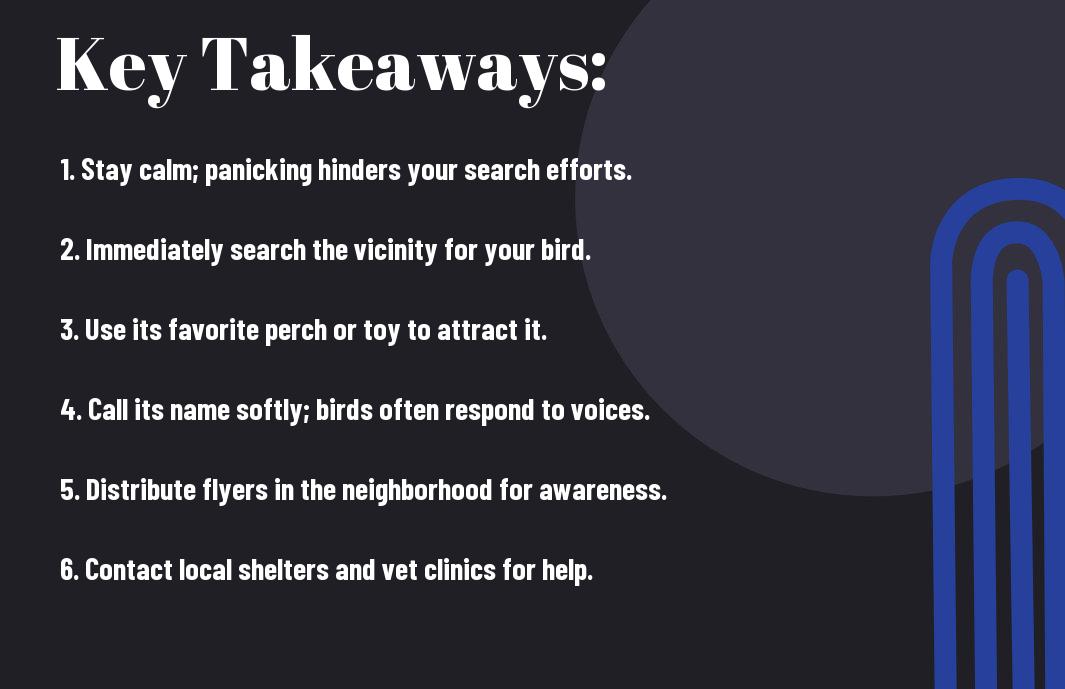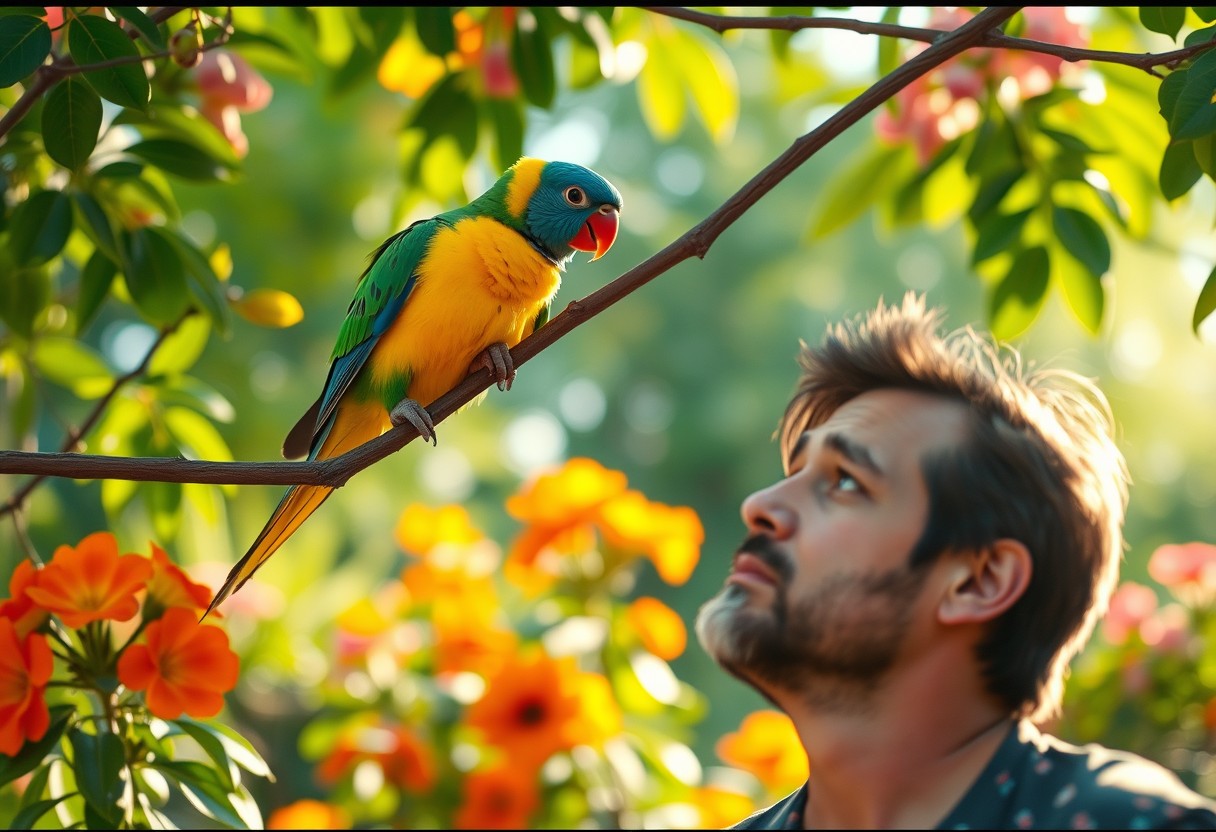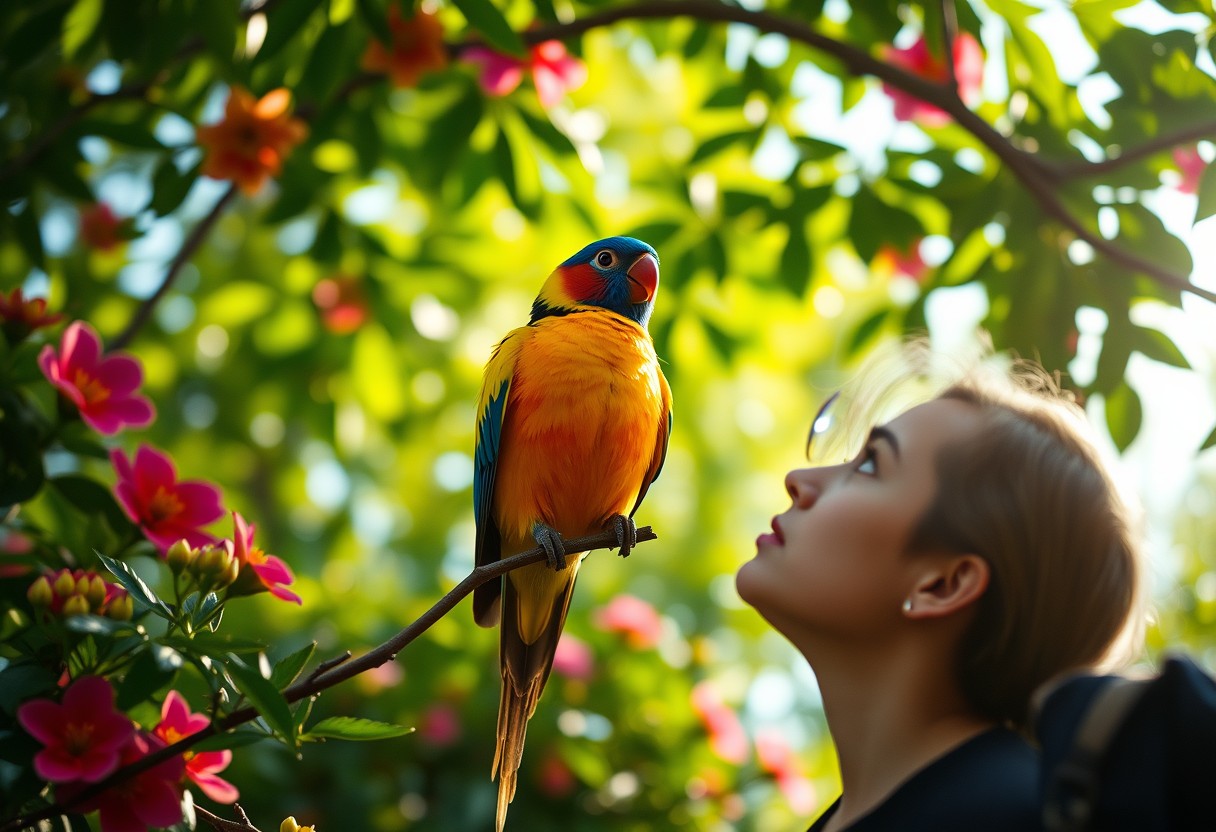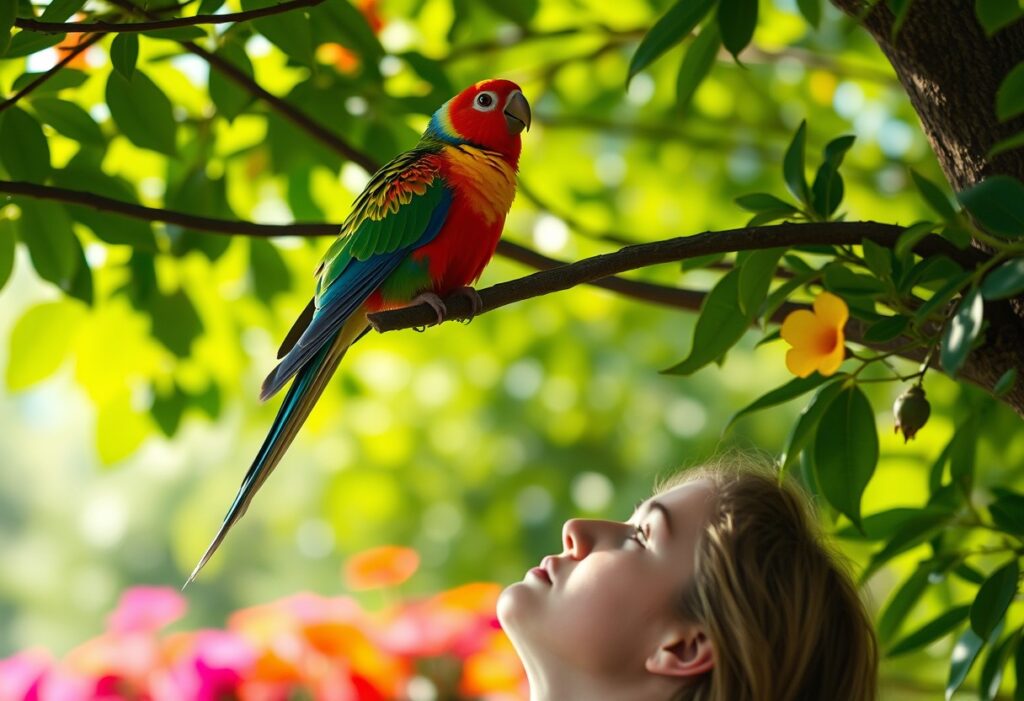Many bird owners face the distressing situation of their feathered friend escaping. If this happens to you, it’s important to act quickly and stay calm. Start by scanning your surroundings and listening for your bird’s call, as they may remain close by. Utilize food, treats, or toys to attract them back, and enlist friends or neighbors to help you search. Be mindful of, approaching gently can prevent your bird from becoming frightened, possibly leading to a successful recovery. Your swift and informed actions can make all the difference in bringing your beloved pet back home safely.

Immediate Actions to Take
While the sudden realization that your beloved bird has escaped can be overwhelming, it’s crucial to maintain a level head. Your bird may be frightened and disoriented, and panicking can make the situation worse. Start by taking a deep breath and putting together a plan of action to maximize your chances of a successful recovery. Consider the weather conditions and what time of day it is, as these factors can influence your bird’s behavior and whereabouts.
Stay Calm and Assess the Situation
For the first few moments, you should take stock of your surroundings and determine how long your bird has been gone. Keep an eye on places where your bird might naturally seek refuge, like trees, ledges, or nearby bushes. Look for any signs of your bird, such as feathers or droppings. If others are present, quickly brief them about your bird’s characteristics to enlist their help. Being organized during this initial assessment lays the groundwork for a more effective recovery attempt.
Call Your Bird’s Name
One of the first things you should do is start calling your bird’s name. Many birds have a strong bond with their owners and can recognize their names or specific phrases. Use a calm and welcoming tone to help attract your bird’s attention. Repeat the name in intervals and include familiar phrases or sounds that may prompt a response from your pet.
For instance, if your bird is used to hearing a particular sound related to feed time, replicate that sound during your search. Familiar calls can help your bird feel less anxious and noticed, increasing the likelihood of their return to you. You can also incorporate a soft whistle or another sound that your bird recognizes as an invitation to come back.
Check Surrounding Areas
For a comprehensive search, methodically check the surrounding areas where your bird could have flown. Begin with the immediate vicinity and expand your search to nearby yards, parks, or any other areas your bird may venture into. Look under bushes, in trees, and around eaves or ledges, as they may have found a perch.
Plus, inform your neighbors about the escape; they may have seen your bird or be able to assist in the search. Consider setting up a small alert system in the form of flyers or social media posts to reach a wider audience. The more eyes looking for your feathered friend, the better your chances of a speedy recovery.
Searching for Your Bird
There’s no greater heartache than realizing your beloved bird has escaped. In this challenging time, swift and organized action can increase your chances of safely recovering your feathered friend. The first step to take is to create a search plan that outlines where you will look, what tools you will need, and how you will spread the word about your lost pet.
Create a Search Plan
The crucial first step is to assess the area around your home. Birds usually stay within a two-mile radius, so plan to search not just your yard but also nearby trees, parks, and open spaces. Make a list of locations to check methodically to ensure that you don’t overlook any possible hiding spots. Bring along any supplies that could help in your search, such as binoculars to get a better view or a net to safely catch your bird if you spot it.
Once you have a list of priority areas to search, set a timeline for your search. Allocate specific times for each area and stick to it. Keep in mind that the more you search in the initial few hours after your bird has escaped, the better the chance of finding it before it gets too far away. Consistency and thoroughness in your search will greatly enhance your chances of a safe recovery.
Use Visual and Auditory Cues
Visual aids can be incredibly effective when searching for your bird. Start by calling your bird’s name in a calm voice as you search. Use familiar phrases, songs, or whistles that your pet is accustomed to. Birds often respond to sounds that signal safety or their owner’s presence, so this technique can help draw your pet close to you.
Visual cues can enhance your search efforts as well. Consider hanging brightly colored, reflective materials in your yard, such as a piece of sheet or fabric that rustles in the wind, which may catch your bird’s attention. Additionally, placing its favorite food outside or leaving its carrier open might attract it back home.
Enlist Help from Friends and Neighbors
Search efforts can feel overwhelming, which is why it’s important to enlist help from your friends, family, and neighbors. Let them know about your lost bird and ask them to keep an eye out while they’re going about their daily routines. You never know which keen eye might spot your feathered friend before you do.
Additionally, helping hands can assist with spreading the word. Encourage those in your network to share social media posts, or create flyers detailing a description of your bird, including a photo and their last known location. This wider reach can significantly improve your chances of finding your bird while keeping your spirits buoyed during your search.
Cues collaborate with visuals and sounds during your search, creating an interactive dialogue with your lost pet. By effectively utilizing both of these elements, you enhance the possibility of getting your pet back home, breaking through the stress and anxiety that can come with their escape.
Searching proactively will not only increase your chances of recovery but will also help you maintain hope during this emotionally taxing time. Be persistent and remember to remain calm, as anxious energy can affect the situation negatively.

Utilizing Technology and Resources
Unlike traditional methods, utilizing technology can significantly enhance your chances of recovering your escaped bird. In today’s digital age, you can tap into various tools and resources to spread the word quickly and effectively. By employing social media platforms and engaging with local online communities, you can reach a larger audience in a shorter amount of time.
Social Media and Online Groups
Technology has revolutionized how we communicate, making it easier to alert others about your lost bird. By posting on popular social media platforms such as Facebook, Instagram, and Twitter, you can share photos and descriptions of your bird, along with the specific location where it was last seen. Additionally, joining local pet groups or bird enthusiast communities can connect you with individuals who might have spotted your feathered friend.
Many local communities have dedicated Lost & Found pet pages where you can post about your escapee. When sharing your post, make sure to include relevant hashtags and keywords to increase visibility, as posts can quickly get buried in feeds. Activating all your connections can create a network of eyes looking for your bird, making it a powerful tool in your recovery efforts.
Local Animal Shelters and Vets
One of the most effective strategies for recovering your bird is reaching out to local animal shelters and veterinary clinics. These establishments often receive reports of found pets, and by informing them about your lost bird, you can tap into their network of caregivers and animal lovers. Make sure to provide detailed information, including your bird’s description, any identifying features, and your contact details.
By regularly following up with shelters and vets, you can establish a rapport and ensure that they keep an eye out for your bird. It’s also wise to visit these places in person when possible, as they may have leads that are not reported online.
Online resources can be invaluable in your search. Many animal control agencies maintain websites or social media pages where they list found animals, making it easier for you to keep track of any sightings or updates related to your escaped bird.
Flyers and Lost Pet Listings
With a well-designed flyer and the strategic placement of lost pet listings, you can significantly enhance your recovery efforts. Create flyers that feature an eye-catching photo of your bird, along with a clear description, your contact information, and any relevant details about where the bird was last seen. Place these flyers in high-traffic areas such as community bulletin boards, local parks, and pet shops.
Don’t overlook the power of online lost pet listing services, which cater specifically to helping reunite lost pets with their owners. Websites and apps like Petfinder, Rover, and local lost pet platforms allow you to post your bird’s information to a targeted audience. The more you can spread the word, the higher the chances of someone seeing your bird.
Shelters and local businesses can be excellent partners in your recovery process. Many are willing to post flyers or share your social media posts, increasing the likelihood of your bird being spotted. Networking with friends and neighbors to support your efforts can also yield positive results in your search.

Prevention Measures for the Future
To ensure that your bird remains safe and secure in your home, it is crucial to take proactive measures. Understanding that prevention is always better than recovery can help you make informed choices to protect your feathered friend from escaping again. Here are some strategies you can implement to create a safe environment for your pet bird.
Secure Your Living Space
With a variety of potential hazards lurking in your home, it’s crucial to conduct a thorough assessment of your space to secure it against possible escapes. Ensure that windows and doors are properly fitted with screens that are sturdy enough to withstand a bird’s curious nature. Additionally, identify any gaps or openings where your bird could sneak out. You may even consider adding locks or alarms to doors and windows that lead outside, enhancing security.
Moreover, keep your bird’s cage in a secure area of your home, away from windows and doors where there is increased traffic. Close all windows and doors when your bird is outside of its cage, and make it a habit to double-check that all exits are secured when you are not actively supervising your pet. By taking these steps, you significantly reduce the risk of an accidental escape.
Train Your Bird for Recall
On another front, actively training your bird for recall can be a lifesaver if the unexpected happens. Establishing a reliable recall command ensures that, should your bird escape, it can return to you quickly and safely. Start by training your bird in a distraction-free environment, using vocal cues and enticing treats to reinforce positive behavior. Consistent practice will help your bird associate the command with returning to you, creating a sense of trust and reliability.
A successful recall training program involves both patience and repetition. Use treats that your bird loves and gradually increase the distance from which you command your bird to return. As your bird becomes more adept, you can introduce distractions, helping to ensure that it will respond even in more chaotic settings. Bear in mind, the goal is to create a strong bond of trust and communication with your feathered companion, which will ultimately enhance its safety.
Regular Health Check-ups
Checkups are crucial for maintaining your bird’s health and well-being. A regular visit to an avian veterinarian can catch underlying issues that may affect your bird’s behavior, including its likelihood to escape. Birds often react to discomfort or pain by displaying erratic behavior; regular examinations can help you stay ahead of any potential health problems. Make it a practice to schedule these check-ups every six months or as recommended by your vet.
Another reason to prioritize regular check-ups is that a healthy bird is usually more content, which may reduce the urge to escape in the first place. A happy, stimulated bird is less likely to find excitement outside their cage. Integrating health monitoring into your routine ensures you are always aware of your bird’s physical and emotional state, which is vital for its long-term happiness and security.
To Wrap Up
Presently, if your bird escapes, it’s crucial to stay calm and act quickly. Begin by thoroughly searching your immediate environment, as many birds tend to stay close to home when they first escape. Use familiar sounds, such as your bird’s favorite whistle or call, to attract them back. Additionally, consider making the area more inviting by placing some of their favorite treats or food outside, as well as their cage, to encourage them to return. Enlisting the help of friends and family can also increase your chances of recovery, as more eyes can help you cover a larger area. Small, localized searches tend to be more effective than larger, drawn-out ones, so focus your efforts where you believe your bird may have landed.
Moreover, don’t underestimate the power of social media and community bulletin boards. Posting about your lost bird on local forums and social media groups can reach a wider audience and lead to potential sightings or tips from your community. Always keep a positive outlook, as many birds have been reunited with their owners after days or even weeks of searching. Recall, staying proactive is your best bet in recovering your lost feathered friend; keep searching, spreading the word, and don’t hesitate to reach out for community assistance in your endeavor.
FAQ
Q: What immediate steps should I take if my bird escapes?
A: If your bird escapes, the first thing you should do is remain calm. Birds can sense panic and may fly farther away. Immediately start calling your bird’s name in a calm and reassuring voice. Check the area around your home, including trees, nearby buildings, and open spaces where birds may land. Use treats, favorite toys, or food to lure your bird back to you. If possible, enlist the help of friends or neighbors to expand your search area while you stay put and call out to your bird.
Q: How can I increase the chances of my bird returning?
A: To increase the chances of your bird returning home, create a familiar environment by leaving the cage door open and putting out some of their favorite food, toys, and perches outside. Birds typically have a strong homing instinct, so familiar scents and sounds can help guide them back. If it’s safe, leave windows open and play their favorite sounds or songs to attract them. Post flyers in your neighborhood and check local social media groups or pet recovery sites to get the word out that your bird is missing.
Q: What should I do if I spot my escaped bird but can’t catch it?
A: If you see your escaped bird but can’t catch it, try to keep the area quiet and avoid sudden movements that could scare it away. Stay nearby and continue to talk to your bird softly. You can use treats to coax them closer, but avoid chasing or trying to grab them, as this may make them fly away. Consider setting up a safe trap, like a cage with food inside, in a quiet and familiar spot to encourage the bird to enter. Monitor the trap closely to ensure it captures your bird without harm.











